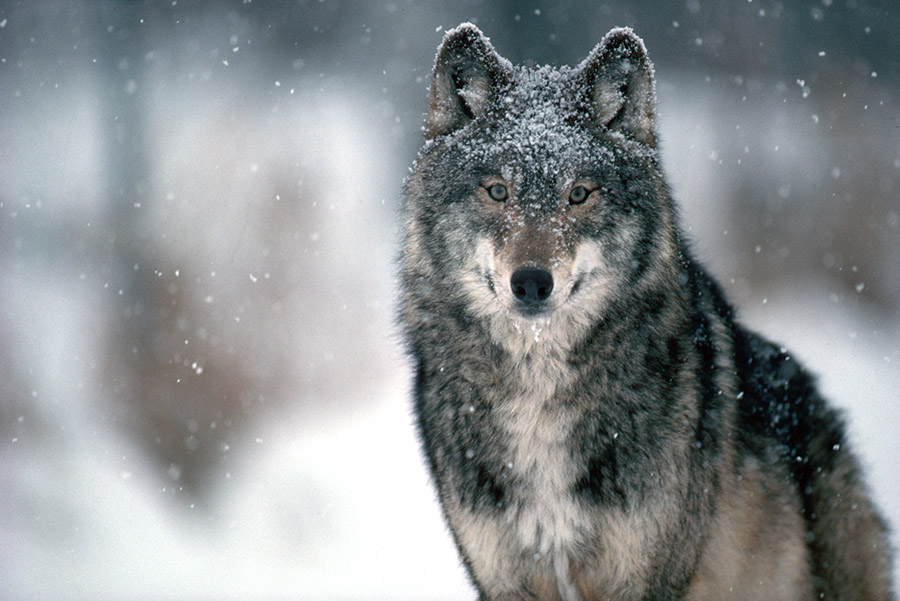For thousands of years, the wolf (Canis lupus) has been an enigma: The Big Bad Wolf of Little Red Riding Hood fairy tale fame, a Wolf in Sheep’s Clothing cliché, and The Wolf of Wall Street all suggest an ancient and modern conflict with this essential apex predator. But there’s nothing to fear; it’s all a myth. Wolves generally avoid humans at all costs because typically, it’s their lives that are lost.
In 2020, Colorado voters passed proposition 114 mandating the return of the gray wolf to the Colorado woods and wilderness. The last Colorado wolf was shot some 80 years ago, in 1942. Since then, the woods have been missing the ancient haunting cry that signaled nature’s balance in the Colorado Rockies, or what the Utes call the Shining Mountains since days immemorial.
Colorado supports the largest elk and deer herds in the continental United States, and the Rocky Mountain West is prime habitat for the North American gray wolff. When healthy wolf populations are present, a trophic cascade results (powerful indirect interactions that can control entire ecosystems), riparian habitats flourish, and biodiversity grows vibrant and strong. This is the effect of apex predators: wolves keep life healthy and thriving by eliminating the old and the weak and keep the herds moving, which allows aspens, willows, and grasses along the rivers to grow and avoid becoming overgrazed.
By making the connection between the environment and the economy, Colorado capitalizes on the $6 million investment made by voting in the wolf’s reintroduction to the wild. In 2016, Ted Turner, through the Turner Endangered Species Fund (TESF), primed the pump with a $1 million investment into the Rocky Mountain Wolf Project, spearheaded by Mike Phillips. The latter also serves as the executive director of TESF and project leader for wolf restoration at Yellowstone National Park in the 1990s.
It took another $5 million raised by a committed group of volunteers over four hard-fought years to get Proposition 114 on the ballot and convince the Colorado electorate to pass the initiative. But pass it did — and only by the slimmest of margins. The conflict between wolves, ranchers, and environmentalists goes back generations. To address this contentious issue since the 2020 passage of 114 and help ensure successful wolf reintroduction by 2023, the Colorado Parks and Wildlife has convened a Technical Working Group and a Stakeholder Advisory Group to encourage collaboration on both sides.
Colorado is an agricultural state comprising 66.3 million acres where about 60% of 7.1 billion in agricultural cash receipts come from livestock production, adding annual economic benefit. But it’s tough to make a living raising livestock, especially cattle. The last thing a rancher wants to worry about after a hard day of doing chores — mending fences, moving water for irrigating fields, planting and harvesting hay, and rounding up cattle, among countless other demands in the daily life of a rancher — is to deal with a pack of wolves taking a cow or a calf. A healthy steer can fetch a few thousand dollars at market.
Colorado also has a thriving outdoor recreation and tourism industry generating $9.6 billion annually and adding 120,000 jobs to the economy. The key is balancing the needs of the state’s ranching and recreation communities, and the reintroduction of the wolf may just be the way to do it. “Thar’s gold in them thar hills” as the saying goes, only this time it runs on four legs. Reintroducing the gray wolf to the Colorado wild creates a bridge between ranchers and conservationists, ecologists and recreationalists, Democrats and Republicans. It increases economic and environmental vibrancy and produces healthy ecosystems — mountains, forests, rivers, and prairies are good for everyone. The wolf’s reintroduction to Colorado is a win-win-win for ranchers, environmentalists, and the majestic wolf itself.



































